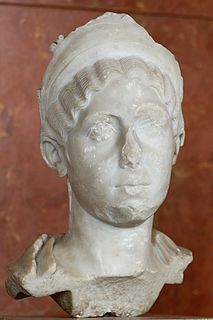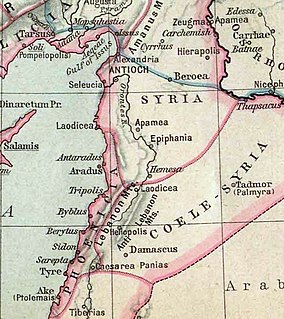
Elagabalus or Heliogabalus, officially known as Antoninus, was Roman emperor from 218 to 222, while he was still a teenager. His short reign was conspicuous for sex scandals and religious controversy. A close relative to the Severan dynasty, he came from a prominent Arab family in Emesa (Homs), Syria, where since his early youth he served as head priest of the sun god Elagabal. After the death of his cousin the emperor Caracalla, Elagabalus was raised to the principate at 14 years of age in an army revolt instigated by his grandmother, Julia Maesa, against Caracalla's short-lived successor, Macrinus. As a private citizen, he was probably named Varius Avitus Bassianus. Upon becoming emperor he took the name Marcus Aurelius Antoninus, and only posthumously became known by the Latinised name of his god.

Marcus Opellius Macrinus was Roman Emperor from April 217 to June 218, reigning jointly with his young son Diadumenianus. As a member of the equestrian class, he became the first emperor who did not hail from the senatorial class and also the first emperor who never visited Rome during his reign. Before becoming emperor, Macrinus served under Emperor Caracalla as a praetorian prefect and dealt with Rome's civil affairs. He later conspired against Caracalla and had him murdered in a bid to protect his own life, succeeding him as emperor.

The Severan dynasty was a Roman imperial dynasty that ruled the Roman Empire between 193 and 235, during the Roman imperial period. The dynasty was founded by the emperor Septimius Severus, who rose to power after the Year of the Five Emperors as the victor of the civil war of 193–197, and his wife, Julia Domna. After the short reigns and assassinations of their two sons, Caracalla and Geta, who succeeded their father in the government of the empire, Julia Domna's relatives themselves assumed power by raising Elagabalus and then Severus Alexander to the imperial office.
The 200s decade ran from January 1, 200, to December 31, 209.
The 180s decade ran from January 1, 180, to December 31, 189.
The 190s decade ran from January 1, 190, to December 31, 199.
Year 165 (CLXV) was a common year starting on Monday of the Julian calendar. At the time, it was known as the Year of the Consulship of Orfitus and Pudens. The denomination 165 for this year has been used since the early medieval period, when the Anno Domini calendar era became the prevalent method in Europe for naming years.
The 210s decade ran from January 1, 210, to December 31, 219.
The 220s decade ran from January 1, 220, to December 31, 229.

Year 204 (CCIV) was a leap year starting on Sunday of the Julian calendar. At the time, it was known as the Year of the Consulship of Cilo and Flavius. The denomination 204 for this year has been used since the early medieval period, when the Anno Domini calendar era became the prevalent method in Europe for naming years.

Year 219 (CCXIX) was a common year starting on Friday of the Julian calendar. At the time, it was known as the Year of the Consulship of Antonius and Sacerdos. The denomination 219 for this year has been used since the early medieval period, when the Anno Domini calendar era became the prevalent method in Europe for naming years.

Legio III Gallica was a legion of the Imperial Roman army. The cognomen Gallica suggests that its earliest recruits came from veterans of the Gallic legions of Gaius Julius Caesar, a supposition supported by its emblem, a bull, a symbol associated with Caesar. The legion was based for most of its existence at Raphanea, Roman Syria, and was still active in Egypt in the early 4th century.

Julia Maesa was a member of the Severan dynasty of the Roman Empire who was grandmother to emperors Elagabalus and Severus Alexander, elder sister of empress Julia Domna, and mother of Julia Soaemias and Julia Mamaea. She wielded influence during the reigns of her grandsons as Augusta of the Empire from 218 to her death, especially on their elevation to emperors.

Julia Soaemias Bassiana was a Syrian noblewoman and the mother of Roman emperor Elagabalus, who ruled over the Roman Empire from 218 to 222. She was one of his chief advisors, initially with the support and accompaniment of her mother Julia Maesa. She and her mother guided the young emperor until growing unrest and a family division led to her son's replacement by her nephew Severus Alexander. Julia Soaemias was killed along with her son by the Praetorian Guard.

Julia Avita Mamaea or Julia Mamaea(14 or 29 August after 180–235) was a Syrian noble woman and a Roman empress of the Severan dynasty. She was the mother of Roman emperor Alexander Severus and remained one of his chief advisors throughout his reign. She was killed in 235 by rebel soldiers along with her son.

Diadumenian was the son and co-ruler of Roman Emperor Macrinus. His mother was Nonia Celsa, whose name may be fictitious. Diadumenian became Caesar in May 217. Elagabalus revolted in May 218, and Diadumenian was elevated to co-emperor. After Macrinus was defeated in the Battle of Antioch, on 8 June 218, Diadumenian was sent to the court of Artabanus V to ensure his safety; however, he was captured and executed along the way, in late June.

The Battle of Antioch was fought between the Roman armies of the Emperor Macrinus and his rival Elagabalus, whose troops were commanded by General Gannys, probably a short distance from Antioch. Gannys' victory over Macrinus led to the downfall of the emperor and his replacement by Elagabalus.

Year 222 (CCXXII) was a common year starting on Tuesday of the Julian calendar. At the time, it was known as the Year of the Consulship of Antoninus and Severus. The denomination 222 for this year has been used since the early medieval period, when the Anno Domini calendar era became the prevalent method in Europe for naming years.
Marcus Julius Gessius Marcianus also known as Gessius Marcianus was a Syrian Roman aristocrat.
Publius Valerius Eutychianus Comazon was a Roman general and ally of emperor Elagabalus. Comazon began his career as an ordinary army recruit under the Emperor Commodus, whom he served as a soldier in the province of Thrace. While there he suffered a demotion from the provincial government under Tiberius Claudius Attalus Paterculianus. However, this incident did not permanently affect his military career.










